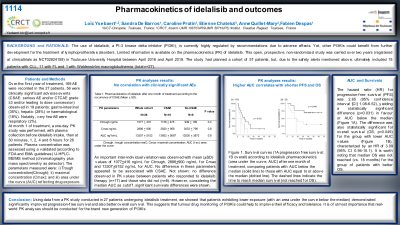Category: General Abstract
1114 - Pharmacokinetics of idelalisib and outcomes

Background
Idelalisib, a phosphoinositide 3-kinase (PI3K) delta inhibitor, has shown high efficacy as an oral drug in the treatment of B-lymphoproliferative disorders. Due to safety concerns, the FDA terminated postmarketing registry trials, leading to the ultimate withdrawal of the drug from the market in 2022. Surprisingly, excluding initial phase 1 trials, little information is available concerning the pharmacokinetics (PK) of idelalisib and its relationship with patient outcome. The study reported here was designed to investigate the relationship between PK (assessed after one month of treatment) and the occurrence of adverse events and outcomes.
Patients and methods
This open, prospective, non-randomized study was carried over two years (registered at clinicaltrials as NCT02824159) in Toulouse (France) University Hospital between April 2016 and April 2019. The study had planned a cohort of 57 patients, but, due to the safety alerts mentioned above, ultimately included 15 patients with CLL, 11 with FL and 1 with Waldenström macroglobulinemia (total n=27). At month 1 of treatment, when drug levels become stable, a one-day PK study was performed, with plasma collection before idelalisib intake, then at 30 minutes, 1, 2, 4 and 6 hours for 26 patients. Plasma concentration was assessed using a validated (according to FDA and EMA guidelines) U-HPLC-MS/MS method (chromatography plus mass spectrometry as detector). The parameters measured were i) trough (Cmin) and Cmax and ii) area under the curve (AUC) reflecting drug exposure.
Results
There were 12 women and 15 men, with a mean age of 68-year-old, all had been previously treated for a median of 3 lines (range 1-6). Idelalisib was prescribed at the classical dosage of 150 mg twice daily. Of the 27 patients, 74% interrupted treatment before the end of the first year, because of adverse event (AE) for 10, progression/relapse for 6 and death for 3.
Over the first year of treatment, 169 AE were recorded in the 27 patients. Of them, 56 were clinically significant adverse events (CSAE: serious AE and/or CTCAE grade ≥3 and/or leading to dose concession) observed in 19 patients. They were mostly gastro-intestinal (35%), hepatic (28%) or hematological (18%). Of note, very little were respiratory (2%).
PK analyses: an important inter-individual variation was observed with mean (+SD) values of 1077+416 ng/mL for SSC, 2886+900 ng/mL for Cmax and 13307+5152 ng/mL for AUC. As shown in table 1, no difference in these parameters appeared to be associated with CSAE. No significant difference was observed either in PK values between patients who responded to idelalisib therapy (n=17) and those who did not (n=8). However, considering the median AUC as cutoff, interesting differences were observed in outcome. Indeed, the hazard ratio (HR) for progression-free survival was 2.65 (95% confidence interval [CI] 1.08-6.52), yielding a statistically significant difference (p=0.003) in favor or AUC below the median. This trend translated into a potential improvement in overall survival (p=0.06) for the group with lower AUC values, characterized by a higher HR of 3.09 (95% CI 0.94-10.1). Alltogether, this study demonstrates that lower overall exposure to idelalisib results in better outcomes.
Conclusions
Available data, including those presented in this study, plead in favor of a controlled assessment of idelalisib PK that would allow to pursue therapy with this drug. This therapeutic drug monitoring approach could be accompanied by appropriate individual dose adjustment to improve PFS/OS with this class of inhibitors, with clinical activity but unwanted toxicities.
Idelalisib, a phosphoinositide 3-kinase (PI3K) delta inhibitor, has shown high efficacy as an oral drug in the treatment of B-lymphoproliferative disorders. Due to safety concerns, the FDA terminated postmarketing registry trials, leading to the ultimate withdrawal of the drug from the market in 2022. Surprisingly, excluding initial phase 1 trials, little information is available concerning the pharmacokinetics (PK) of idelalisib and its relationship with patient outcome. The study reported here was designed to investigate the relationship between PK (assessed after one month of treatment) and the occurrence of adverse events and outcomes.
Patients and methods
This open, prospective, non-randomized study was carried over two years (registered at clinicaltrials as NCT02824159) in Toulouse (France) University Hospital between April 2016 and April 2019. The study had planned a cohort of 57 patients, but, due to the safety alerts mentioned above, ultimately included 15 patients with CLL, 11 with FL and 1 with Waldenström macroglobulinemia (total n=27). At month 1 of treatment, when drug levels become stable, a one-day PK study was performed, with plasma collection before idelalisib intake, then at 30 minutes, 1, 2, 4 and 6 hours for 26 patients. Plasma concentration was assessed using a validated (according to FDA and EMA guidelines) U-HPLC-MS/MS method (chromatography plus mass spectrometry as detector). The parameters measured were i) trough (Cmin) and Cmax and ii) area under the curve (AUC) reflecting drug exposure.
Results
There were 12 women and 15 men, with a mean age of 68-year-old, all had been previously treated for a median of 3 lines (range 1-6). Idelalisib was prescribed at the classical dosage of 150 mg twice daily. Of the 27 patients, 74% interrupted treatment before the end of the first year, because of adverse event (AE) for 10, progression/relapse for 6 and death for 3.
Over the first year of treatment, 169 AE were recorded in the 27 patients. Of them, 56 were clinically significant adverse events (CSAE: serious AE and/or CTCAE grade ≥3 and/or leading to dose concession) observed in 19 patients. They were mostly gastro-intestinal (35%), hepatic (28%) or hematological (18%). Of note, very little were respiratory (2%).
PK analyses: an important inter-individual variation was observed with mean (+SD) values of 1077+416 ng/mL for SSC, 2886+900 ng/mL for Cmax and 13307+5152 ng/mL for AUC. As shown in table 1, no difference in these parameters appeared to be associated with CSAE. No significant difference was observed either in PK values between patients who responded to idelalisib therapy (n=17) and those who did not (n=8). However, considering the median AUC as cutoff, interesting differences were observed in outcome. Indeed, the hazard ratio (HR) for progression-free survival was 2.65 (95% confidence interval [CI] 1.08-6.52), yielding a statistically significant difference (p=0.003) in favor or AUC below the median. This trend translated into a potential improvement in overall survival (p=0.06) for the group with lower AUC values, characterized by a higher HR of 3.09 (95% CI 0.94-10.1). Alltogether, this study demonstrates that lower overall exposure to idelalisib results in better outcomes.
Conclusions
Available data, including those presented in this study, plead in favor of a controlled assessment of idelalisib PK that would allow to pursue therapy with this drug. This therapeutic drug monitoring approach could be accompanied by appropriate individual dose adjustment to improve PFS/OS with this class of inhibitors, with clinical activity but unwanted toxicities.
.jpg)
Loic Ysebaert, MD, PhD
Professor of Hematology
IUCT Oncopole
Toulouse, Midi-Pyrenees, France- FD
- EC
- SD
- PC

